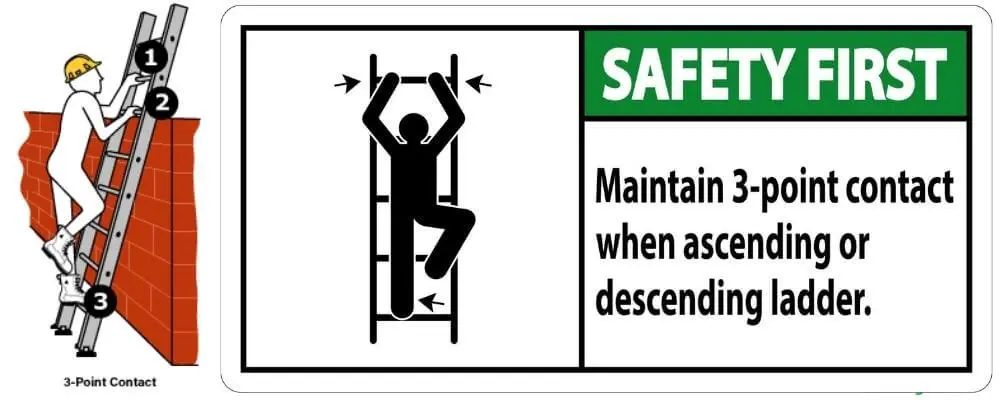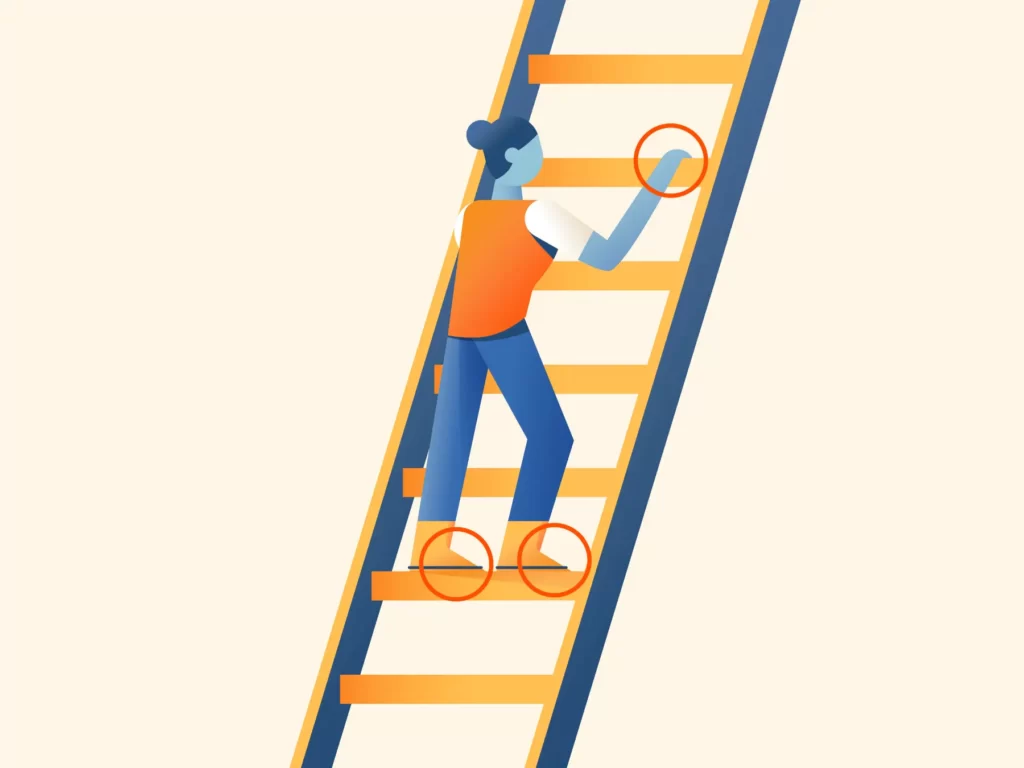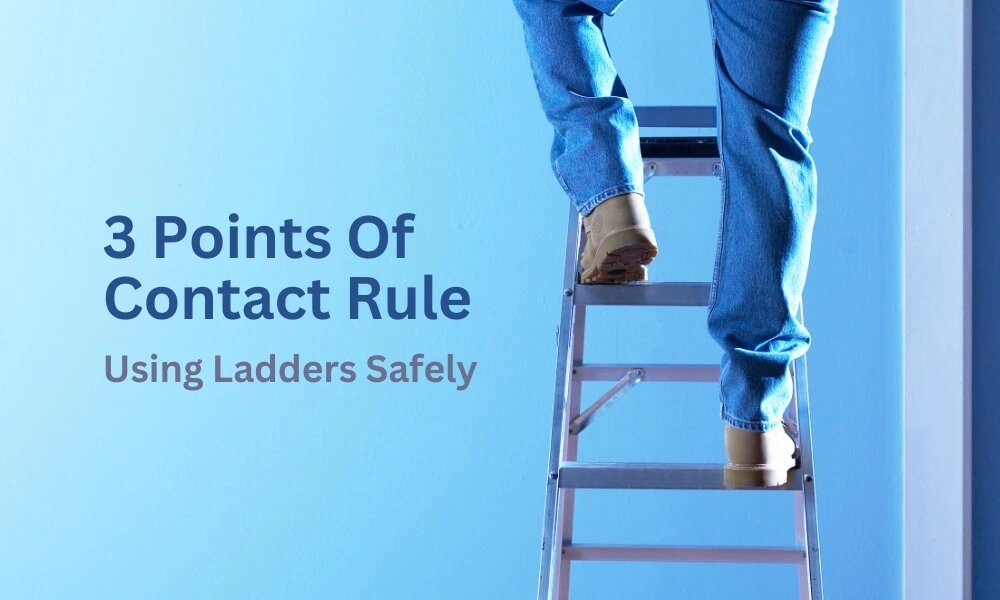Ladder accidents are one of the most common causes of workplace injuries and fatalities. According to the Occupational Safety and Health Administration (OSHA), falls from ladders account for over 20% of all workplace fatalities. That’s why it’s crucial to follow proper ladder safety procedures to minimize the risk of accidents. One important guideline for ladder safety is the three points of contact rule. In this blog, we will explore what the three points of contact rule entail, why it is essential, and how you can follow it to ensure your safety when using a ladder.
3 Points Of Contact Rule Of Ladder Safety
The Three Points of Contact rule is a crucial safety principle that must be observed when utilizing a ladder. This rule emphasizes the importance of maintaining three points of contact with the ladder at all times, which translates to either having both feet and one hand or both hands and one foot in contact with the ladder throughout the process.

The rationale behind this rule is that it ensures stability and minimizes the risk of falling off the ladder. Maintaining three points of contact distributes your weight more evenly, thus providing better balance and reducing the likelihood of a slip or a fall. Additionally, it is essential to avoid climbing higher than the third rung from the top of the ladder. As you climb higher, the ladder becomes less stable, increasing the fall risk and potential injury.
If it is necessary to work at a height above the third rung, consider using a scaffold or another approved platform instead of a ladder. These alternatives provide a more stable working surface, significantly reducing the risk of accidents and enhancing overall safety.
Adhering to the Three Points of Contact rule is vital for ladder safety. This fundamental rule should never be overlooked or compromised, as it plays a significant role in preventing accidents and ensuring your well-being while using a ladder.
The 3 Points of Contact rule is a proven method for reducing the chances of falling from a ladder, and it is taken very seriously by safety professionals. By instructing users to maintain contact with the ladder using at least three out of their four limbs at all times, it provides a consistent approach to ladder safety. In other words, always ensure that you have two hands and one foot or two feet and one hand in contact with the ladder throughout the task.
By following this principle and prioritizing ladder safety, you can greatly reduce the risk of slips and falls, protecting yourself and others from potential injuries or accidents.
This system allows the person to have maximum stability and support, thereby reducing the likelihood of slipping and falling.

Importance Of 3 Points Of Contact Rule
The 3 Points of Contact Rule is a fundamental safety guideline when using ladders. It ensures that a user maintains three points of contact with the ladder at all times (two hands and one foot, or one hand and two feet). This rule is important for several reasons:
- Balance and stability: Maintaining three points of contact helps users to distribute their weight evenly and maintain balance while ascending or descending a ladder. This reduces the risk of falls, slips, or losing control while on the ladder.
- Prevents overreaching: The rule helps prevent users from overreaching or leaning too far to one side, which can cause the ladder to become unstable and result in falls or injuries. By following the 3 Points of Contact Rule, workers are encouraged to move the ladder closer to the task, reducing the need for overreaching.
- Reduces fatigue: By maintaining three points of contact, users can relieve stress on their arms and legs, reducing fatigue and the likelihood of accidents due to tiredness or loss of strength.
- Encourages proper ladder use: The rule promotes the correct use of ladders, including choosing the right type and size of ladder for the task, setting it up properly, and following manufacturer guidelines. This reduces the risk of accidents and injuries caused by improper ladder use.
- Builds safety awareness: The 3 Points of Contact Rule encourages a safety culture among workers by highlighting the importance of ladder safety. It reinforces the need for constant vigilance and awareness while using ladders, which can help to prevent accidents and injuries.
The 3 Points of Contact Rule is a crucial component of ladder safety that helps maintain balance and stability, prevents overreaching, reduces fatigue, encourages proper ladder use, and fosters a culture of safety awareness. By following this rule, users can minimize the risk of accidents and injuries while using ladders in various settings.
Safety Rules To Follow When Using Ladders
- To use ladders safely, always maintain three points of contact. That means two hands and one foot or two feet and one hand on the ladder at all times.
- Moving quickly often results in only 2-point contact. You often have to make a conscious effort to maintain 3-point contact.
- Break 3-point contact only when you reach the ground or a stable platform.
- Tie off or secure the top and bottom of the ladder to prevent movement.
- Put both hands firmly on the rungs before stepping onto a ladder.
- Always face the ladder when you’re climbing up and down.
- Keep your center of gravity between the side rails. Don’t lean out on either side.
- Keep both feet on the ladder when standing on it. Never straddle the space between a ladder and another object
- Make sure that the ladder extends at least 90 cm (3 ft) above the top landing.
- Make sure the ladder meets the requirements of Grade 1, Grade 1A, or Grade 1AA ladder according to CSA Z11-12: Portable Ladders.

When climbing a ladder, you must have both hands free and face the ladder. This allows for three points of contact with the ladder at all times and reduces the chances of falling.
Position the ladder so it is:
- Not blocking any paths, exits or doors
- On level, solid footing
- Against a stable structure
- Set up at a 4:1 angle
- Extended at least three feet above the surface to be accessed
- Secured at the top and bottom
When using the ladder:
- Don’t let your belt buckle pass beyond either ladder side rail
- Hold the ladder with one hand while working with the other
- Don’t hurry or skip rungs/steps
Do…
- Wear suitable footwear: something silly like sandals or barefoot just won’t cut it.
- Make sure you clean dirt or anything slippery from your shoes.
- Put ladder legs on solid, even ground.
- Center your body between the rails when you are climbing and face the ladder at all times.
- Don’t hold the rails if possible – hold the rungs! Holding the rungs give you much better control if your foot slips.
- Use extra caution when alighting the ladder: such as checking for any ground obstacles.
- Make sure your hands are free. Try attaching your tools or materials to the ladder itself. Heavier loads should be raised and lowered separately using a pulley system.
Don’t…
- Don’t try to move ladders while standing on them.
- Never overreach to the side: keep yourself centered at all times.
- Don’t jump off a ladder: You might land on an uneven surface and you might strain yourself.
- Never move too quickly: This often violates the 3 points of contact rule of ladder safety. Be conscious about maintaining your 3 points of contact at all times.
- Don’t overload the ladder: Take the ladder load ratings into consideration – such as the weight of any equipment you use.
In conclusion, the Three Points of Contact rule is a fundamental and indispensable guideline for ladder safety. Ensuring that you maintain consistent contact with the ladder using either both feet and one hand or both hands and one foot significantly enhances your stability and reduces the risk of falls. Additionally, avoiding climbing higher than the third rung from the top and opting for alternative platforms like scaffolds when necessary further contributes to a safer working environment.
By diligently adhering to the Three Points of Contact rule and prioritizing ladder safety, you can protect yourself and others from potential injuries and create a safer work environment for all. Remember, ladder safety is a responsibility that should never be taken lightly, and following this time-tested rule can make all the difference.

